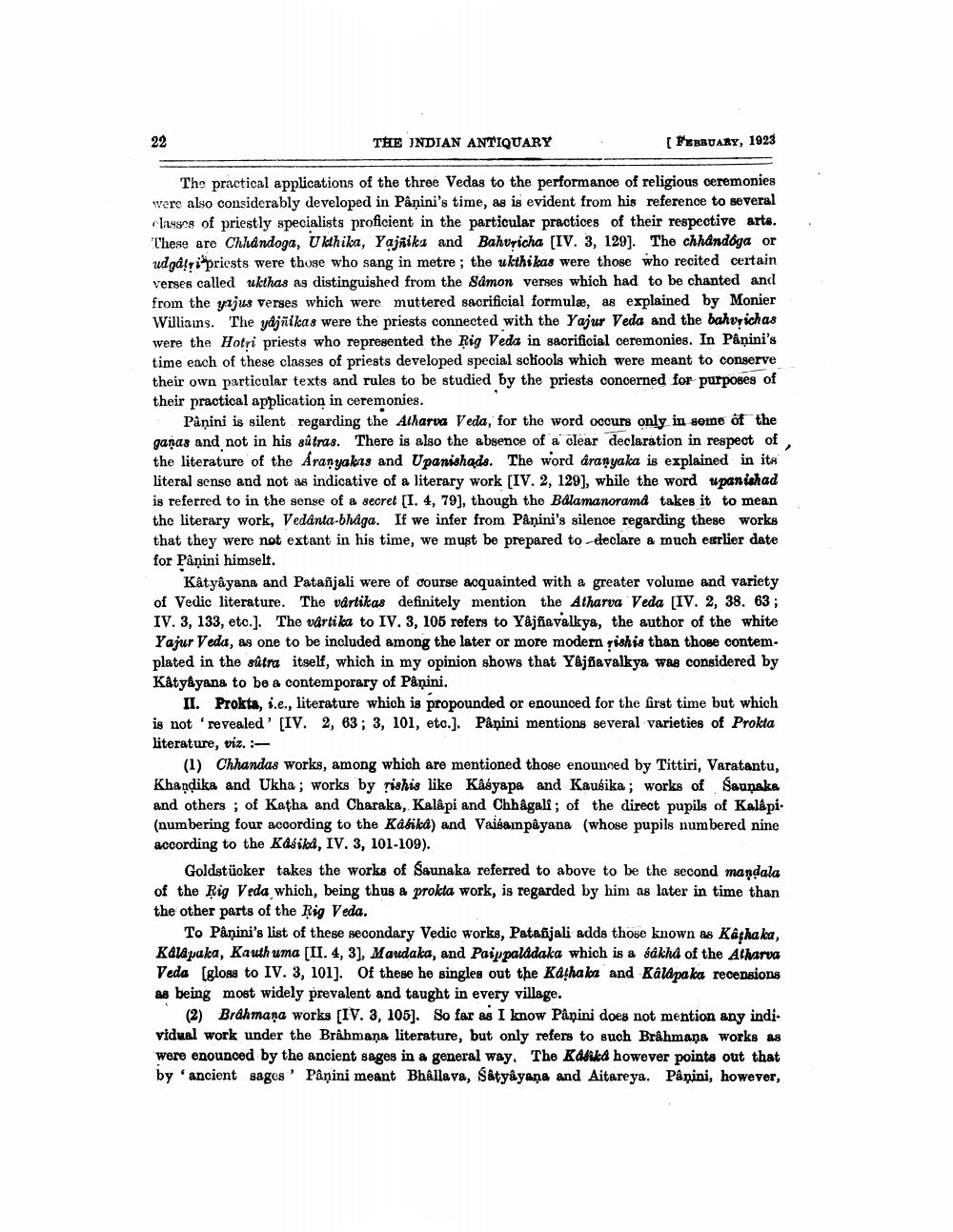________________
22
THE INDIAN ANTIQUARY
(PEBRUARY, 1923
The practical applications of the three Vedas to the performance of religious ceremonies were also considerably developed in Pånini's time, as is evident from his reference to several class of priestly specialists proficient in the particular practices of their respective arts. "These are Chhandoga, U kthika, Yajnika and Bahuricha (IV. 3, 129). The chhandóga or udgår i priests were those who sang in metre; the ukthikas were those who recited certain verses called ukthas as distinguished from the Samon verses which had to be chanted and from the yujus verses which were muttered sacrificial formula, as explained by Monier Williains. The ydjñikas were the priests connected with the Yajur Veda and the bahvichas were the Hotri priests who represented the Rig Veda in sacrificial ceremonies. In Panini's time each of these classes of priests developed special schools which were meant to conserve their own particular texts and rules to be studied by the priests concerned for purposes of their practical application in ceremonies.
Påņini is silent regarding the Atharva Veda, for the word occurs only in some of the ganas and not in his sû tras. There is also the absence of a clear declaration in respect of the literature of the Aranyalons and Upanishads. The word aranyaka is explained in its literal sense and not as indicative of a literary work (IV. 2, 129), while the word u panishad is referred to in the sense of a secret [I. 4, 79), though the Balamanorama takes it to mean the literary work, Vedanta-bhaga. If we infer from Pånini's silence regarding these works that they were not extant in his time, we must be prepared to declare a much earlier date for Påņini himself.
Katyayana and Patañjali were of course acquainted with a greater volume and variety of Vedic literature. The vårtikas definitely mention the Atharva Veda [IV. 2, 38. 63; IV. 3, 133, etc.). The varti ka to IV. 3, 105 refers to Yåjfiavalkya, the author of the white Yanur Veda, as one to be included among the later or more modern rishis than those contemplated in the sutra itself, which in my opinion shows that Yajavalkya was considered by Katyayana to be a contemporary of Påņini.
II. Prokta, i.e., literature which is propounded or enounced for the first time but which is not revealed ' [IV. 2, 63; 3, 101, etc.). Påņini mentions several varieties of Prokta Literature, viz.
(1) Chhandas works, among which are mentioned those enounced by Tittiri, Varatantu, Khandika and Ukha; works by rishis like Kâsyapa and Kausika; works of Saunaka and others; of Katha and Charaka, Kalậpi and Chh&gali; of the direct pupils of Kalápi. (numbering four according to the Katika) and Vaisampâyana (whose pupils numbered nine according to the Kašika, IV. 3, 101-109).
Goldstüoker takes the works of Saunaka referred to above to be the second mandala of the Rig Veda which, being thus a prokta work, is regarded by him as later in time than the other parts of the Rig Veda.
To Pâņini's list of these secondary Vedic works, Patañjali adds those known as Kashaka, Kala paka, Kauth uma [II. 4, 3), Mardaka, and Paippaladaka which is a sakha of the Atharva Veda (gloss to IV. 3, 101]. Of these he singles out the Kathaka and Kalapaka recensions as being most widely prevalent and taught in every village.
(2) Brahmana works (IV. 3, 105]. So far as I know Panini does not mention any individual work under the Brahmana literature, but only refers to such Brahmaņa works as were enounced by the ancient sages in a general way. The Kafika however points out that by ancient sages' Pâņini meant Bhållava, Šatyâyana and Aitareya. Pâņini, however,




